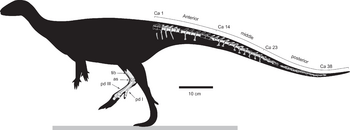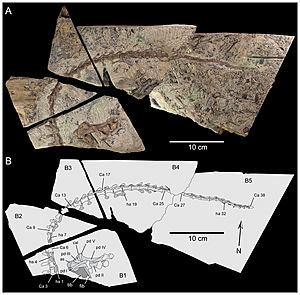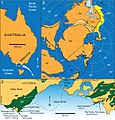Diluvicursor facts for kids
Quick facts for kids Diluvicursor |
|
|---|---|
 |
|
| Skeletal diagram showing the remains of Diluvicursor's holotype | |
| Scientific classification |
|
| Kingdom: | Animalia |
| Phylum: | Chordata |
| Clade: | Dinosauria |
| Order: | †Ornithischia |
| Clade: | †Neornithischia |
| Clade: | †Elasmaria |
| Genus: | †Diluvicursor Herne et al., 2018 |
| Type species | |
| †Diluvicursor pickeringi Herne et al., 2018
|
|
Diluvicursor (say "Dih-loo-vih-CUR-sor") means "flood runner." It was a small dinosaur that lived in Australia during the Early Cretaceous period, about 113 to 112 million years ago. This dinosaur belonged to a group called ornithischians, which were plant-eating dinosaurs. We only know about one type of Diluvicursor, called Diluvicursor pickeringi. Scientists found its first bones in 2005. They officially named this dinosaur in 2018.
Contents
Discovering Diluvicursor
The bones of Diluvicursor were found in 2005. They were discovered in the Eumeralla Formation in Victoria, southeastern Australia. This area is near a famous fossil site called Dinosaur Cove. Many other dinosaur bones have been found there before.
The place where Diluvicursor was found is called the "Eric the Red West Sandstone" (ETRW). Scientists first wrote about this discovery in 2009. They thought the bones might belong to a type of ornithopod, which are plant-eating dinosaurs that walked on two legs.
Naming the Dinosaur
Scientists officially described and named Diluvicursor in January 2018. They also studied the rocks and environment where the bones were found.
The name Diluvicursor comes from two Latin words. Diluvi means "flood" or "deluge." This part of the name was chosen because the main fossil was found in a fast-moving river. The dinosaur likely lived on a prehistoric floodplain. The second part, cursor, means "runner."
The specific name, pickeringi, honors David A. Pickering. He was a person who greatly helped with palaeontology (the study of fossils) in Australia. He passed away around the time the study was being prepared.
What We Know About Diluvicursor
The main fossil, called the holotype, is almost a complete tail. It also includes parts of the lower right leg, like ankle bones and toe bones. This fossil was found in five pieces on a stone plate. Scientists believe the dinosaur's body got caught in plant debris in a tree stump in a deep, fast-moving river. This main fossil is from a young Diluvicursor.
Another fossil, a tail bone from a larger Diluvicursor, was found nearby. This shows that adults were bigger than the young one.
Size of Diluvicursor
The young Diluvicursor fossil was about 1.2 meters (4 feet) long. This is about the size of a modern wild turkey. However, its tail was curled up, making it hard to measure exactly. So, this size estimate might not be perfect.
Based on the larger tail bone found, adult Diluvicursor dinosaurs were probably at least 2.3 meters (7.5 feet) long. This is closer to the size of a rhea, a large bird. Even at this size, Diluvicursor was still considered small for an ornithopod dinosaur. Scientists also noted that Diluvicursor was built more strongly than other similar dinosaurs from the same area.
Images for kids
See also
 In Spanish: Diluvicursor pickeringi para niños
In Spanish: Diluvicursor pickeringi para niños





